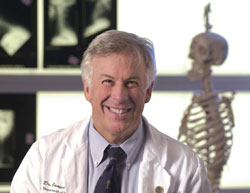
For Release: 5 PM ET, May 30, 2007
Contact: Deborah Kimbell, 603-653-0887 / 802-236-6934 (cell)
Second SPORT Study Results: Clear Advantage of Surgery for Spinal Stenosis and a Slipped Vertebra

Dr. James Weinstein
HANOVER, NH—In one of the three most common back conditions for which patients seek treatment, surgery proved to have substantially better results than non-surgical remedies, according to Dartmouth-led research published in the May 31 New England Journal of Medicine. The paper is the second in a series detailing the findings of the Spine Patient Outcomes Research Trial (SPORT), a seven-year, $21 million national study funded by the National Institutes of Health.
In cases of degenerative spondylolisthesis with spinal stenosis, a condition that affects six times as many women as men and is especially prevalent among African-American women, surgery was twice as effective as non-surgical approaches in reducing pain and restoring functionality for patients.
This publication follows the release of earlier SPORT findings in November, which looked at patients seeking treatment for disk herniation with sciatica. For that condition, the difference in outcomes between the surgical and non-operative groups was less.
"The SPORT study was undertaken with one purpose in mind: to give physicians and patients solid information that would allow them to make informed choices when faced with a decision of how to treat their back condition," said lead author Dr. James N. Weinstein, professor and chair of orthopaedics at Dartmouth Medical School and Dartmouth-Hitchcock Medical Center.
Although back surgeries are among the most common surgical procedures performed in the United States, until SPORT, there had been only a few very small controlled trials to gauge their effectiveness.
Degenerative spondylolisthesis (DS) is the forward slippage of one lumbar vertebra on the one below it. It generally occurs after age 50. It is not clear why it occurs more often in African-American women. Although DS alone generally causes no symptoms, in some cases it can result in spinal stenosis--narrowing of the spinal canal which causes pressure on the nerves--resulting in significant pain in the legs that is worsened by simply taking a walk.
SPORT followed 601 patients diagnosed with DS and symptomatic spinal stenosis. Of those, 372 received surgery within two years and 235 remained non-operative. Two years after enrollment in the trial, while non-operative patients reported only modest improvement in their condition, patients who had surgery reported significantly reduced pain and improved functionality. Surgical patients saw relief from symptoms fairly quickly, reporting major improvements as early as six weeks after their operation.

Non-operative treatments included physical therapy, steroid injections, and medicines to relieve pain. Surgery involved relieving pressure on the nerves through removal of bone and soft tissue in a procedure called a decompressive laminectomy.
"As a surgeon, it's very important to me that I have evidence that I can share with my patients as they are trying to decide how to proceed with treatment," Weinstein said. "Up until now, we suspected surgery produced better results, but we had little objective data to support that. With the results of this study, we can now discuss much more fully the surgical and non-surgical options available to our patients so that they can make an informed choice."
Although the study was designed to look at a randomized and an observational cohort, fully 40 percent of participants who had been randomized changed their minds after enrollment in the trial and switched to the other group, i.e. choosing to have surgery after being randomized to the non-operative group, or deciding to proceed non-surgically after being randomized to the surgical group. As a result of the substantial crossover between surgical and non-surgical groups in the randomized cohort, the authors chose to publish the results based on what treatment was actually received in each group. While this is not a randomized comparison, the analysis carefully controlled for differences that existed between the two groups at the outset.
The third major SPORT study, on the effectiveness of surgery vs. non-surgical options for spinal stenosis without any spondylolisthesis, is expected to be released later this year. Additional papers based on the wealth of data gathered from the entire SPORT process will be published over the next several months.
Co-authors on the DS article were Jon D. Lurie MD MS; Tor Tosteson ScD; Brett Hanscom MS; Anna N.A. Tosteson ScD; Emily A. Blood MS; Nancy J.O. Birkmeyer PhD; Alan S. Hilibrand MD; Harry N. Herkowitz MD; Frank P. Cammisa MD; Todd Albert MD; Sanford E. Emery MD MBA; Lawrence G. Lenke MD; William A. Abdu MD MS; Michael Longley MD; Thomas J. Errico MD; and Serena Hu MD.
Centers enrolling patients in the study in addition to Dartmouth-Hitchcock Medical Center were: Wm. Beaumont Hospital, Royal Ok, MI; Emory University, Atlanta; NYU/Hospital for Joint Diseases, New York; Hospital for Special Surgery, New York; Kaiser Permanente, Oakland, CA; Nebraska Foundation for Spinal Research, Omaha; Rothman Institute at Thomas Jefferson University Hospital, Philadelphia; Rush Presbyterian-St. Luke's Medical Center, Chicago; University of California, San Francisco; University Hospitals of Cleveland/Case Western Reserve University, OH; Washington University, St. Louis; Maine Spine and Rehabilitation, Scarborough.
For more information, go to: www.dartmouth.edu/sport-trial.
-DMS-